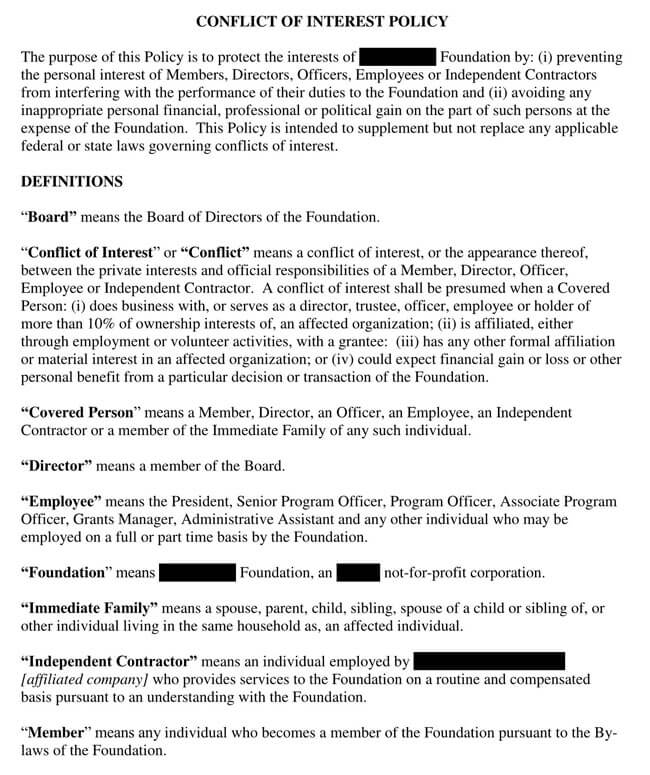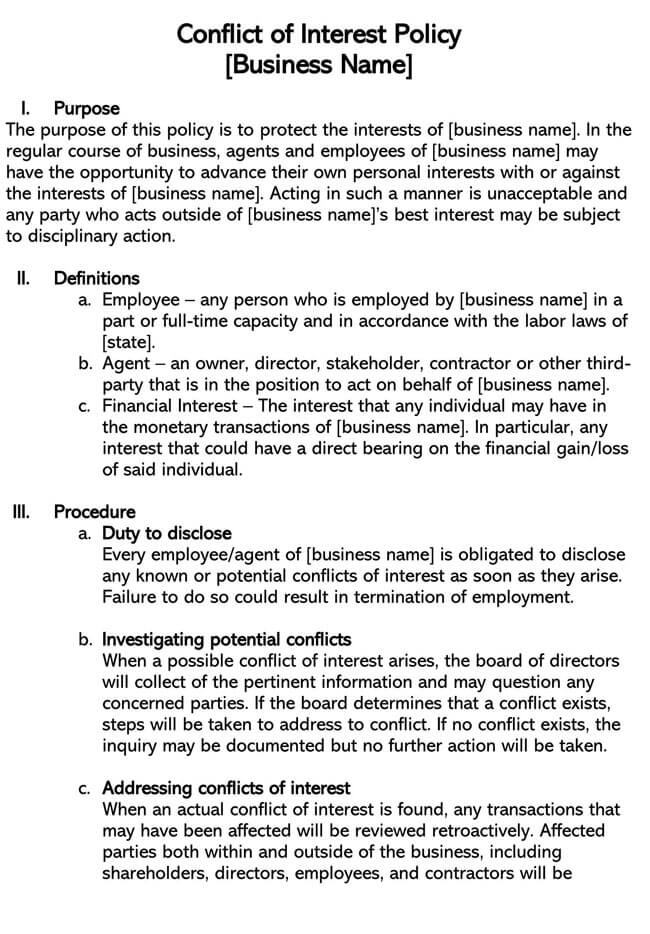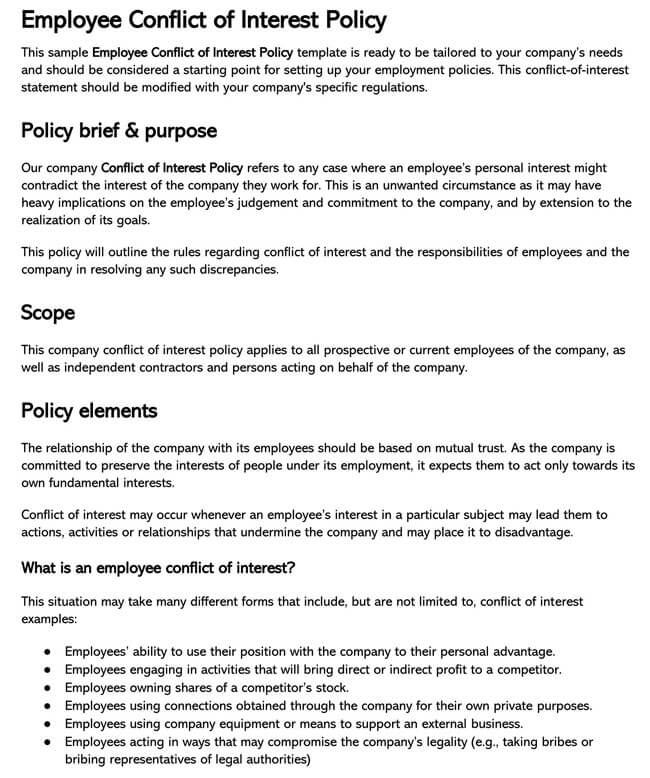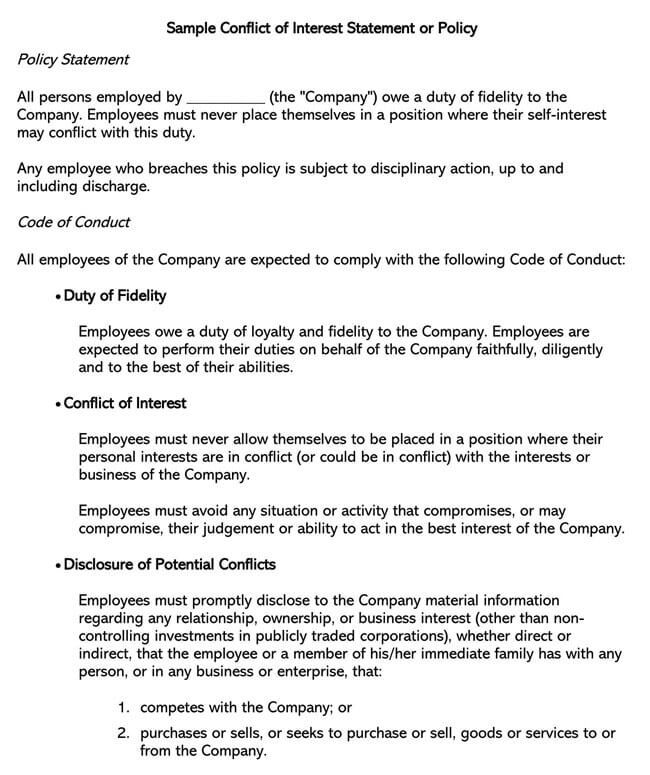Immediately you sign an employment contract, every employee becomes an asset of the organization. This means that you need to adhere to the organization’s laws both in letter and in spirit. This means that every employee needs to observe strict compliance with the organization’s rules and codes of conduct. That being said, employees should avoid situations that can create perceived or actual conflict between their interests and those of the organization.
However, not every employee will find the ride as smooth as intended to be. They will find some situations more attractive to their own personal interests than the company’s interest. This can compromise the employer-employee relationship big time. To avoid this, an Employee Conflict of Interest Policy will come in handy in providing guidelines that prevent it from occurring.
Employee Conflict of Interest Policy
Conflicts of interest happen in most workplaces. By definition,
Conflict of interest is a situation where an employee is involved in an activity or behavior that benefits them and not their employer.
Usually, when such conflicts occur at the workplace, the employees’ ability to make decisions or perform duties effectively is often affected.
It is a legal document issued by the employer to their employees, describing a situation under which such a situation may occur.
This document is sometimes referred to as conflict-of-interest avoidance, work conflict-of-interest policy, conflict-of-interest policy, conflict-of-interest policy for employees, or work conflict-of-interest policy.
Free Templates




Things to Include in the Policy
The following are some important components of such a policy:
Possible conflicts
While there are various conflicts that may arise in a workplace, mentioning all of them helps create awareness among employees. The following are examples that are common in workplaces:
- Starting a parallel business like that of your employer
- Having a romantic relationship with your subordinate, supervisor, or other employees.
Disciplinary action details
Explaining the disciplinary action details is important as it lets the employees be aware of what actions will follow should their interests conflict with those of the company.
Depending on the severity of the conflict of interest, there are various disciplinary types an employer may decide to take. These include warning, loss of certain privileges, suspension, or termination.
The procedure of conflict handling
This section helps the employee know the step-by-step procedure followed when addressing the conflict of interest. Usually, the board of directors will institute the most appropriate procedure to use when handling conflicts.
Statement for employee
Depending on the employees’ job position, they should always provide their own statement about any conflict of interest under their duty.
Employees signature
In your policy document, you need to spare some space where the employee will append their signature. Signatures are very necessary for this process as it acknowledge the receipt of the policy. Also, by appending their signatures, the employees agree to conform to the contents of the policy document.
Crafting the Employee Conflict of Interest Policy
While some find creating this policy difficult, the following guide will ease the work for you.
Describe the purpose
First and foremost, you need to describe your policy in brief. This will help enlighten your employees about the policy, what to expect from it, and how to behave as they perform their duties.
State relevant interests
Generally, there are various kinds of problems that can occur in the workplace. For example, an employee may be dating a supervisor, hence receiving special treatment. Or, an employee refers the employers’ clients to another business they share a financial interest with. While there are many examples to give, it’s important that you explain all the potential and relevant conflicts in the document.
Outline the procedure
In this part of the document, you need to include an in-depth illustration of the conflict-handling procedure in a manner that is understandable to everyone. Note that the procedure should show a step-by-step guide on how investigations and resolutions will be made.
Here is a grasp of the standard procedure you can use when handling a conflict of interest:
Duty to disclose
First, the employer will inform his/her staff members to disclose any potential conflict of interest in the workplace. Failure to report it will allow them to be held responsible. If an employee spots it but chooses to remain silent, they risk being terminated or suspended from the company.
Investigation of conflicts
In this part, the board of employment will investigate the potential conflict of interest by questioning the involved persons. If it exists, then appropriate corrective actions will be taken. However, if the board of management finds no conflict, it will only be documented and no further action taken after that.
Addressing conflict of interest
If the investigations report one, then the board of management will dig deep into it. Also, the extent will be determined. If the board finds strong evidence of misconduct, then the party will be subjected to appropriate disciplinary action.
Disciplinary action
In this part, the board of management will settle on an appropriate disciplinary action as per the offense committed. The action can either be in the form of warning, suspension, or termination.
Include a consent form
The policy document should have a space where the employee appends his/her signature. By signing the form, the employee acknowledges abiding by the contents of the policy document. Also, the signature brings the legal bond. This means that the document can be used as proof of engagement in a court of law.
Applicable Laws
Generally, there are no specific laws that regulate such policy. However, it is advisable that the employer provide exhaustive information about the guidelines to prevent employees from violating the policy.
Frequently Asked questions
A conflict of interest is when a staff/worker takes part in an activity that benefits them and not their employer. Usually, such activities affect the productivity of the company, hence discouraged by employers.
The key factor in preventing it in the workplace is honest and open communication with your seniors. If you suspect it arising, don’t hesitate to share it with your bosses. As an employer, you need to provide your staff with a policy to make this possible.
Conflicts of interest are common phenomena in most workplaces. When they occur, both the employer’s and the employees’ personal gains will be at odds with each other. This can lead to severe consequences such as job termination. In order to avoid this, always make sure you provide your staff with a policy about it.








